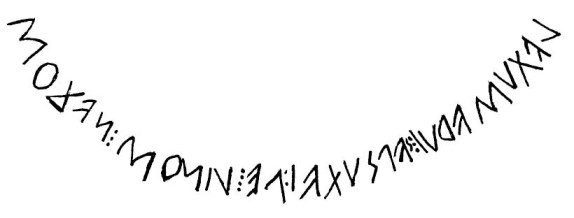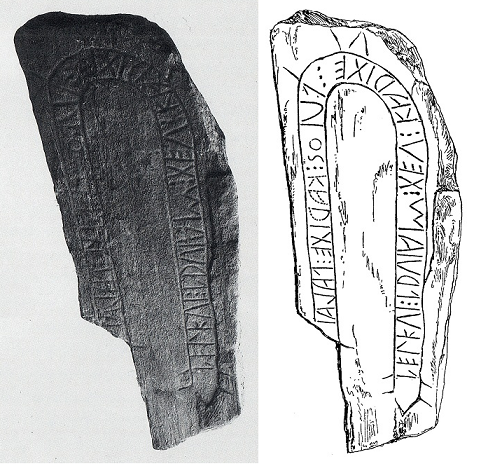Examples of writing
Lepontic:Ormevasso

Source:
http://www.univie.ac.at/indogermanistik/quellentexte.cgi?46
laTumarui : saPsuTai : Pe : uinom : našom
“For Latumaros and Sapsuta, Naxian wine”
The inscription, incised on a vase for wine of a type called spinning top [fiasca a trottola], comes from tomb 84 in the necropolis of Ornavasso (VB). It dates to between the end of the 2nd century B.C. and the beginning of the 1st century B.C. The writing direction is right to left.
This short phrase shows a nominal inflection system which is typical of an Indo-European language, with the names of the two dedicatees, a male and a female, in the dative connected by the enclitic conjunction -pe, equivalent to -que in Latin, followed by a nominal phrase. Latumaros and Sapsuta are two proper names: Sapsuta would be a non-Celtic name, although inflected as a Celtic word, whilst Latumaros would contain a recognizable Celtic element -maros “great”, common in personal names, and a root that can be linked to the Gaulish lato- “ardor, fury”. uinom is clearly a term for “wine” and našom is the adjective indicating the Greek town of Naxos, in Sicily, famous for the precious wine.
Lepontic: Prestino

Source: Michel Lejeune - Lepontica, Paris: Les Belles Lettres, 1971. Planche XII.
This sandstone stele almost 4m long was found by chance in 1966 at Prestino, Como, during construction work for a motorway. Subsequent excavations brought to light a building complex dating back to 480-450 B. C. that was likely either public or sacred.
Many people consider the inscription, incised in the so-called Lugano alphabet, to be the most ancient known in a Celtic language (6th-5th cent. B. C.). It has the peculiarity of having a verbal element and three signs (θ, v and z) which are quite unusual in Lepontic. The writing direction goes right to left.
uvamoKozis : Plialeθu : uvlTiauioPos : ariuonePos : siTeś : TeTu
"Vamogotsis Blialedu laid (this) stele for the Uvltiauio- Ariuo-"
Its structure can be analysed as follows: double name of the dedicant in the nominative, followed by the double name of the dedicatees in the dative plural (-bos), the object of dedication in the accusative and finally a third person singular verb which seems to be a preterit doubling. As regards syntax, it has the SOV order of archaic phrases, while another inscription from Vergiate has instead the SVO order. The prevailing theory is that Lepontic was slowly evolving from the first to the second; the documents found to date do not allow the formulation of more structured hypotheses. As for verbal morphology, the Lepontic shares an innovative feature with Gaulish, the preterit in -t-, inherited from the Indo-European imperfect.

Source:
http://www.univie.ac.at/lexlep/wiki/VA%C2%B76_Vergiate
Funeral stele dating to 6th-5th cent. B.C. found in 1913 at Vergiate (VR), near San Gallo church and now held in Milan in the museums of the Sforza castle.
pelkui : pruiam : teu : karite : iṣ́ọs : kalite : palaṃ[
"Deu set up (?) the tomb (?) for Belgos ; he raised the stone"
The inscription clearly shows a two sentence structure, with two parallel verbs in preterit (karite, kalite) and two object nouns in the accusative singular (pruiam, palaṃ). Both the analysis and the translation are uncertain. The first term seems to be a dative singular of the name of the recipient of the offer, followed by the name of the object dedicated, whilst the dedicant in the nominative could be teu; iṣ́ọs could be a demonstrative pronoun in the nominative. As far as the two objects are concerned, Pala, already known through other inscriptions, always in a funeral context, could be translated as "stele". The interpretation of Pruia is more difficult; according to many scholars, it may recall the Gaulish term briua "bridge, pavement".